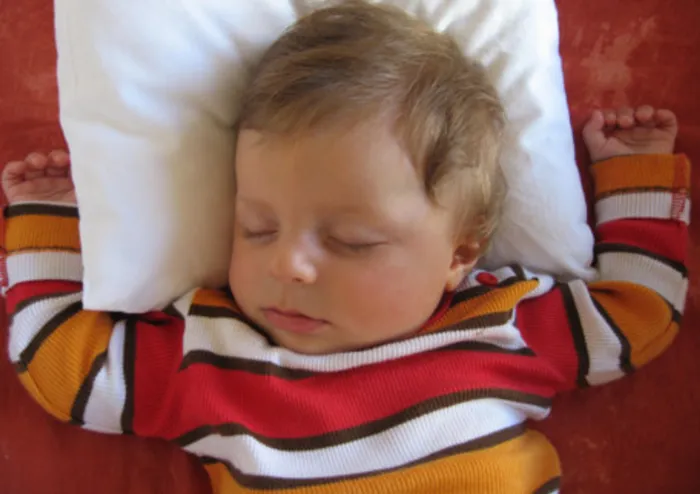How to keep sleeping babies alive

A study has concluded that babies are much more likely to remember something if it is associated with a positive emotion. A study has concluded that babies are much more likely to remember something if it is associated with a positive emotion.
Washington - I still put my two-year-old to sleep on his back, even though each morning he’s snuggled on his tummy, head shoved into a corner of his crib.
The “back to sleep” message has become ingrained in my psyche, as the campaign to reduce sudden infant death syndrome (SIDS) was designed to do when it began 20 years ago after studies showed that placing babies to sleep on their stomachs tripled the risk of SIDS.
SIDS, in which an infant dies during sleep from an undetermined cause, can be a huge source of anxiety for new parents.
The latest research into SIDS is giving parents clearer guidelines for protecting babies during sleep.
For example, a recent analysis of more than 1 400 SIDS cases found that having a baby sleep in the parents’ bed increases the risk of SIDS by a factor of five for infants younger than three months.
Bed-sharing presents a risk because, as paediatrician Linda Fu explains, the airflow around the baby may not be good enough, “and that is all it takes”.
In the past 10 years, researchers have identified how low oxygen levels, combined with an underlying brain defect, can cause SIDS. Scientists believe a triple-risk model explains many SIDS cases: a baby has a defect in an area of the brain that controls breathing and arousal; the baby is at an age when those brain areas are immature; and the baby is exposed to an external stress that compromises his breathing or oxygen levels or causes overheating.
“To have a SIDS death, you have to have at least one of those (factors), and you have a higher risk if you have two or three of those happening at the same time,” says Professor Fern Hauck of the University of Virginia School of Medicine in Charlottesville.
Sleeping face down on a soft surface or with soft bedding that can press up against the face can decrease oxygen flow too much. When this happens, a normal baby will auto-resuscitate by gasping, crying, turning his head or moving.
“It is thought that SIDS infants have a defective arousal mechanism, which means they stay in that position and gradually suffocate,” Hauck says.
Overheating is thought to lead to SIDS in a similar way, by suppressing an infant’s arousal response. That is why many parents have stopped using soft bedding and bumper pads in cribs and switched to wearable blankets to lower the risk of suffocation.
The connection between brain defects and SIDS was raised definitively in 2010 when researchers discovered that SIDS babies were deficient in the brain-signalling chemical serotonin in the brain stem. According to some research, between 50 and 75 percent of infants who die of SIDS have a serotonin defect.
Other researchers have found that between 10 and 15 percent of SIDS deaths can be traced to babies with a genetic predisposition for long QT syndrome, a heart rhythm disorder that can go undetected and lead to cardiac arrest, says Marta Cohen, a paediatric pathologist at Sheffield Children’s Hospital in England.
Also, SIDS researchers say smoking tobacco while pregnant may cause a rewiring of the unborn baby’s brain in areas important for breathing and arousal, making maternal smoking one of the largest risk factors for SIDS. It’s conceivable that newborns might one day be screened for low serotonin levels in the brain stem or for genes that are involved in faulty arousal, Cohen says, but that day is far off.
So what should parents of newborns do?
According to Hauck, who helped write the American Academy of Pediatrics guidelines about SIDS, parents should:
* Avoid smoking, alcohol and illegal drugs during pregnancy and after birth.
* Place the baby on his back every time he is put to sleep.
* Use a firm sleep surface, with no soft objects or loose bedding in the crib. “Putting a baby into an empty crib looks awful, like you are torturing them,” Hauck acknowledges. “But the truth is, the babies don’t really care.” All that comfy stuff is really for the parents, she says.
* Share bedrooms, but not beds. Many SIDS researchers believe a rise in bed-sharing may explain the plateauing of SIDS rates in developed countries. They say between 50 and 70 percent of SIDS cases in the past few years have occurred in a bed-sharing scenario.
“We’re now in the position we were 20 years ago with sleeping prone,” Carpenter says. “If we could get rid of bed-sharing, the whole picture could change with SIDS. That’s our hope.”
* Practise breast-feeding. No one is sure why this helps, but breast-fed babies have a lower risk.
* Consider using a dummy for naps and bedtime (after the first month, if the baby is breast-feeding).
* Avoid overheating the baby and the baby’s room.
* Follow the routine immunisation schedule.
* Finally, avoid products marketed as reducing the risk of SIDS. (None has been proved to do so.) – The Washington Post